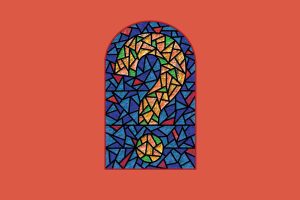
Fra Angelico [Public domain], via Wikimedia Commons
In Dante Allegheri’s epic poem Inferno, those words are inscribed over the gates of hell. Written in the 14th century as part of a trio of poems known collectively as The Divine Comedy, the Inferno depicts Dante’s journey through the various levels of hell. In each level, sinners are afflicted with punishments appropriate to their sins.
The popularity of the Inferno—it is a staple of college classrooms—and the relative obscurity of the other two parts of the Divine Comedy (Purgatory and Paradise) illumines an odd feature in the history of art: Depictions of hell and its torments have generally been more popular than depictions of heaven. “Human beings often find vice more interesting than virtue,” says Mia Mochizuki, professor of art history and religion at the Jesuit School of Theology at Santa Clara University.
Christian art, though, has not always focused on the details of hell’s torments the way Dante did. The earliest renderings of hell are found in icons that show how Jesus “descended into hell” to liberate the souls of the just. This image was grounded in the belief that heaven had been closed to human beings until the sacrifice of Christ on the cross.
The shift toward more graphic images of hell begins in the medieval period, notes Mochizuki. With most of the population illiterate, visual art—paintings, tapestries, sculptures—both shaped and reflected the Christian narrative. “There was increased focus on the fate of the individual, whether they would be saved or damned,” says Mochizuki.
Some of the earliest surviving works from this period depict hell as a great mouth consuming the bodies of the damned. The Italian painter Fra Angelico drew on this image when he painted his 15th-century work The Last Judgment, which shows Satan chewing on the body of a person condemned to hell. The taste for striking imagery spread to music as well. The 13th-century poem “Dies Irae,” which describes a judgment day of “heaven and earth in ashes,” was ultimately incorporated into the Catholic funeral liturgy.
With the coming of the Reformation in the 16th century, depictions of hell began to be used more polemically. “Artists tended to depict their political or theological opponents in hell,” observes Mochizuki.
A new technology—the printing press—made possible the mass distribution of woodcuts, used as a teaching tool for a largely illiterate population. One woodcut of the period shows the pope in hell, depicted as a great mouth.
Hell has been a source of inspiration for writers as well as visual artists. John Milton’s Paradise Lost depicts hell as the place that Satan and his fellow angels are consigned to after their failed rebellion. “Better to reign in hell than serve in heaven,” growls Satan. Although written, in Milton’s words, “to justify the ways of God to men,” literary critics have noted that the poem also reflects the poet’s criticism of religious and political hierarchy.
In the 20th century we see a turn toward a more relational understanding of heaven and hell. In C.S. Lewis’ The Great Divorce, hell is depicted as a gray, depressing English city where the residents avoid one another and nurse their private resentments. They are offered a chance to visit heaven and even remain if they wish. This requires, however, that they face painful truths about themselves—most are unwilling to do so.
The advent of television and film allowed artists more room than ever to depict hell using all the computer-generated special effects at their disposal. The film Constantine (2005), for example, envisions hell as a post-apocalyptic city populated by monstrous demons that torture the souls of the damned. In the television series Buffy the Vampire Slayer, by contrast, hell is seen less as a destination for souls and more as the home of evil beings who prey upon humanity.
The persistence and diversity of artistic depictions of hell suggest they respond to needs that are deeper than the theological claims of a particular religious tradition. They also are cultural expressions of how human beings have wrestled with the problem of evil and the challenges of human freedom. As long as we continue to walk this earth, hell will always be with us.
Related: Has hell frozen over?
This article appeared in the November 2011 issue of U.S. Catholic (Vol. 76, No. 11, pages 14-15).












Add comment